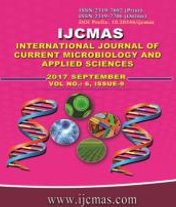


 National Academy of Agricultural Sciences (NAAS)
National Academy of Agricultural Sciences (NAAS)

|
PRINT ISSN : 2319-7692
Online ISSN : 2319-7706 Issues : 12 per year Publisher : Excellent Publishers Email : editorijcmas@gmail.com / submit@ijcmas.com Editor-in-chief: Dr.M.Prakash Index Copernicus ICV 2018: 95.39 NAAS RATING 2020: 5.38 |
Escherichia coli are recognized indicators of faecal contamination. However, this perspective has changed with the ability of some strains of E. coli to cause human illness. The pathogenic E. coli strains can cause a variety of diseases, including diarrhoea, dysentery, and haemolytic uremic syndrome, bladder and kidney infections. Different strains are usually associated with different diseases; this versatility of E. coli strains is due to the different strains possessing unique virulence genes. Though E. coli contamination of tropical seafood is quite common, the distribution of different pathogenic types in seafood is not studied in detail except for Shiga toxin producing E. coli. The objective of this study was identification of the pathotypes, if any, associated with them. E. coli was isolated from several fresh and frozen finfish samples, molluscs, cephalopods and crustacean shellfishes, and water and sediment samples. Among the different aquatic environment and seafood samples examined, only two squids and one flat fish sample was found positive for the presence of the virulence gene, eaeA. These three samples yielded atypical EPEC (eaeA+, bfp-, stx-), while being negative for other virulence genes by PCR. Other samples though positive for E. coli, did not possess the virulence genes. The results highlight the presence of some of the pathotypes of E. coli in seafood samples and hence are recognized as a potential threat to human health.
 |
 |
 |
 |
 |